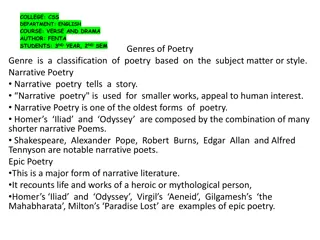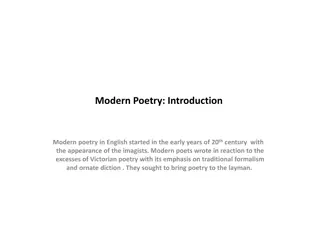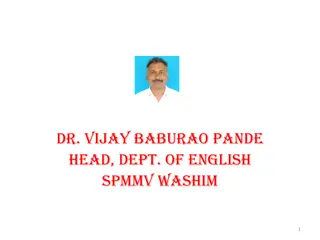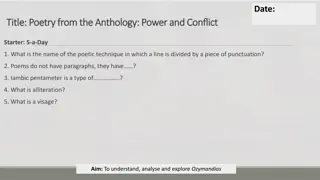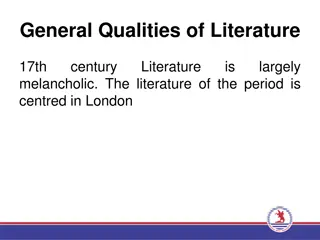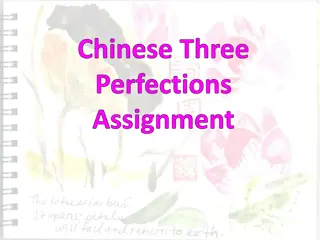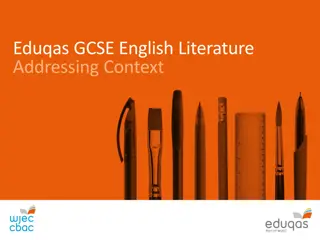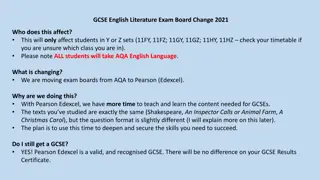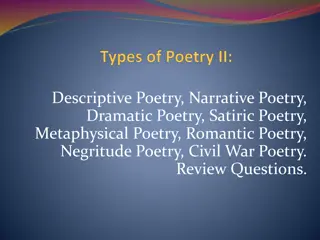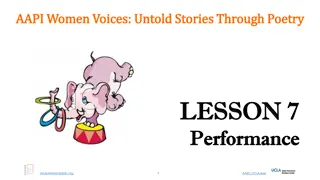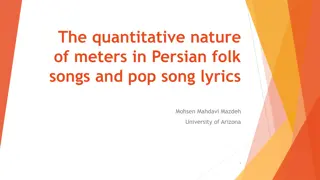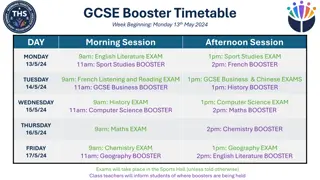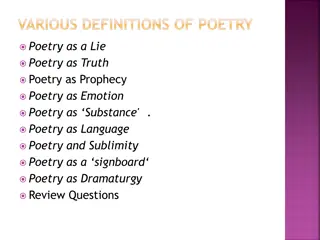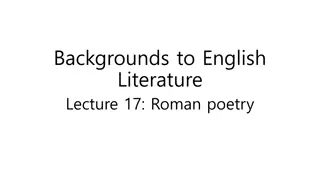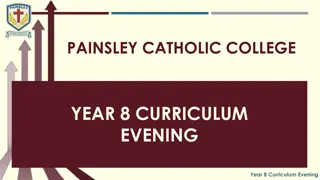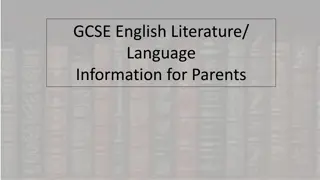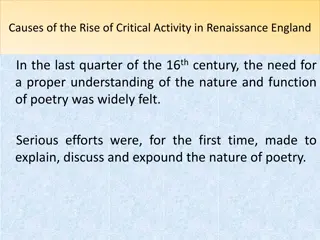GCSE English Literature: Poetry Section Overview
The GCSE English Literature Poetry Section Overview provides insights into the discussion topics, comparison requirements, course progress review, teaching focus areas for Anthology and unseen poetry, as well as networking plans for September 2016. It also outlines the format, weightage, and content of the poetry section in Paper 2, emphasizing the Anthology and unseen poetry comparisons. Additionally, details about answering questions in Section B, Part 1 from the Anthology collection are included, highlighting the structure and guidelines for the named poems. The overall presentation aims to assist students in understanding and preparing for the poetry section effectively.
Download Presentation

Please find below an Image/Link to download the presentation.
The content on the website is provided AS IS for your information and personal use only. It may not be sold, licensed, or shared on other websites without obtaining consent from the author.If you encounter any issues during the download, it is possible that the publisher has removed the file from their server.
You are allowed to download the files provided on this website for personal or commercial use, subject to the condition that they are used lawfully. All files are the property of their respective owners.
The content on the website is provided AS IS for your information and personal use only. It may not be sold, licensed, or shared on other websites without obtaining consent from the author.
E N D
Presentation Transcript
Click to edit Master title style Click to edit Master text styles Second level Third level Fourth level Fifth level Network events GCSE English Summer 2016
Click to edit Master title style Points for discussion Click to edit Master text styles Second level Third level Fourth level Fifth level Discussion of the comparison requirements across both English Language and English Literature Review of the first year how has the course been going? Discussion and activity to focus on the teaching of the Anthology and unseen poetry sections for GCSE English Literature Paper 2 Networking and discussion of plans for September 2016
Click to edit Master title style Click to edit Master text styles Second level Third level Fourth level Fifth level English Literature - Poetry
A reminder of the requirements Click to edit Master title style The poetry section is the last part of paper 2 Click to edit Master text styles Second level Third level Fourth level Fifth level There are two sections with students focussing on comparing two poems from the anthology for the first question and then moving onto comparing unseen poems in the second section. The poetry section of the paper is worth 25% of the whole GCSE English Literature course with the Anthology comparison at 12.5% and the unseen poetry comparison at 12.5%
The Anthology poetry Click to edit Master title style Students are asked to answer ONE question in Section B, Part 1 from the collection of poems that they have studied Click to edit Master text styles Second level Third level Fourth level Fifth level the student s choice. The question will be on one named poem from the anthology collection, reproduced on the question paper and another poem of These poems will be listed on the question paper to remind students of the poetry titles and poets. The named poems will be taken from any of the 15 poems and any of the 15 could appear throughout the lifetime of the qualification Students are advised to spend up to 35 minutes on this section
The question Click to edit Master title style The question will always follow the same format. Click to edit Master text styles Second level Third level Fourth level Fifth level Compare how xxxxx is presented in the two poems In your answer, you should consider the: Re-read xxxx Choose one other poem from the xxxx anthology. poets use of language, form and structure influence of the contexts in which the poems were written (total for Question = 20 marks)
Assessment Objectives for the Anthology Click to edit Master title style poetry Click to edit Master text styles Second level Third level Fourth level Fifth level and the contexts in which they were written AO2 Analyse the language, form and structure used by a writer to create meanings and effects, using relevant subject terminology where appropriate AO3 Show understanding of the relationships between texts There is also a requirement to compare the two poems Total of 20 marks
Examples of context Click to edit Master title style These have been taken from the lesson plans for the Conflict poems which can be found on the website and/or accessed via ActiveTeach Click to edit Master text styles Second level Third level Fourth level Fifth level Offer students some brief background notes on the poet and the poem. . This poem is about the birth of [Gillian Clarke s] daughter, Catrin, and her relationship with her. Catrin: Exposure: Explain that Exposure is a poem based on Owen s grim experiences of trench warfare in the winter of 1917 and takes passive suffering as its theme (e.g. the repetition of Nothing happens points to this).
Expectations Click to edit Master title style Students will compare two poems. If only one poem is considered, the mark cannot go beyond Level 2. Click to edit Master text styles Second level Third level Fourth level Fifth level include relevant contextual points. Students will use evidence/quotations from the printed poem to support points and comment on language, form and structure and For the second poem, although students may wish to include memorised quotes, as this is a closed book examination, this is not an expectation. Paraphrasing will be sufficient when referencing the second poem. Students must demonstrate their knowledge of a second poem.
Balance Click to edit Master title style Students should provide some balance between the coverage of the two poems. Of course, some poems are longer than others, but this is taken into consideration. The coverage of the two poems need not be equally weighted but the second poem should have substantial treatment. Click to edit Master text styles Second level Third level Fourth level Fifth level Students should explore as much of the two poems as they can within the given suggested time and should comment on specific examples of language, form and structure. Quotations should be used from the printed poem in the question paper, but we do not expect all quotations or examples from the second poem to be entirely accurate, as they are recalled from memory during examination conditions.
Structure of responses Click to edit Master title style The structure of responses varies from student to student and ability. Some will be able to provide a response that compares like-for-like throughout the response, others will find this difficult and like to write about each poem separately and then draw comparisons at the end. Whichever method is used, the full range of marks can be awarded. Click to edit Master text styles Second level Third level Fourth level Fifth level Students must remember that although the structure of the response can vary, they must remember to compare and write about both poems as they will not be able to move out of level 2 if only one poem is covered.
Unseen poetry Click to edit Master title style In this section of the paper, students are presented with two unseen Click to edit Master text styles Second level Third level Fourth level Fifth level The question carries 20 marks. poems to compare. It is suggested that students should spend about 45 minutes on this section of the paper. Words considered complex may be glossed, if deemed necessary. The question and poems will fit on a two-page spread. Poems will also be labelled Poem 1 and Poem 2 students can refer to Poem 1 or 2 rather than using the full title(s). The selected poems will be suitable for all abilities to access and write about.
Click to edit Master title style Assessment Objectives for the Unseen poetry AO1 Read, understand and respond to texts. Students should be able to: maintain a critical style and develop an informed personal response, use textual references, including quotations, to support and illustrate interpretations. Click to edit Master text styles Second level Third level Fourth level Fifth level AO2 Analyse the language, form and structure used by a writer to create meanings and effects, using relevant subject terminology where appropriate There is also a requirement to compare the two poems Total of 20 marks
The choice of unseen poems Click to edit Master title style The topic or subject matter of the two poems will not be too complex. Click to edit Master text styles Second level Third level Fourth level Fifth level must be written by any published poets can be international The poems selected: will be contemporary (post-1945) will not be used by any other awarding organisation s set text list will not feature in any support materials will not be commonly taught at KS3 will be at least 30 lines combined total. Wherever possible, the poems will not be too long.
The question Click to edit Master title style The question will always follow the same format: Click to edit Master text styles Second level Third level Fourth level Fifth level In your answer, you should compare: Compare the ways the writers present xx [the key word / words] in xx [name of Poem 1] and xx [name of Poem 2]. the ideas in the poems the poets use of language the poets use of form and structure. Use evidence from the poems to support your comparison
Approaches to the question Click to edit Master title style The same approach to answering the anthology question can be applied. Click to edit Master text styles Second level Third level Fourth level Fifth level If only one poem is discussed for each part of the question, the mark awarded cannot progress beyond the top of Level 2. Comparison is essential for both Parts 1 and 2 of Section B of the paper Please be reassured by the examiner reports for our current specification the examiners often comment on how well the candidates respond to unseen poems
Click to edit Master title style Click to edit Master text styles Second level Third level Fourth level Fifth level Teaching the poetry requirements
Ways of approaching a poem and points of Click to edit Master title style comparison You will all have lesson plans and key elements which you include when teaching poems and how to compare key elements of the poems. Click to edit Master text styles Second level Third level Fourth level Fifth level methods and lessons which you know work! These are all still relevant and please continue to use The following is just for discussion and another way to enable students to feel confident about poetry analysis
VOICE register tone Click to edit Master title style How would I read this poem aloud? Is there anything about the poem which makes it difficult for me to read it aloud? Click to edit Master text styles Second level Third level Fourth level Fifth level Does the poem's tone of voice suggest a particular attitude towards the Does the voice in this poem sound as if it's coming from a particular time or place? Who seems to be speaking in this poem? Who is the poem speaking to? reader? Is the poem characterised by a particular kind of vocabulary, or style of sentence? Does the tone of voice suggest a particular attitude towards the subject matter of the poem? Is there more than one kind of voice in the poem? If so, what's the relationship between the two?
FORM pattern typography Click to edit Master title style Is there a formal structure to this poem? Does it have a regular metrical Click to edit Master text styles Second level Third level Fourth level Fifth level period? pattern? Is there a rhyme scheme? Could someone sing this poem? Are there other ways in which this poem is patterned? What elements of repetition are there? Is this form associated with a particular type of poem, or particular What typographic conventions does the poem use, or not use? How does that contribute to the style or voice of the poem? Do any of these things help me in understanding what kind of poem this is? Does the form of the poem emphasise any aspect of its meaning?
IMAGERY metaphor representation Click to edit Master title style Which image first caught my attention? Which image is most central to Click to edit Master text styles Second level Third level Fourth level Fifth level Do some of the images suggest strong positive or negative connotations? what the poem has to say? Did any of the images surprise me? Are some of these images metaphorical? What things are being superimposed here? How does this add to my understanding? Do certain images connect with each other, to create a particular mood or attitude or impression? Are there contrasting images in the poem? How does these contribute to meaning? Does it relate to shifts in the narrative or argument?
NARRATIVE argument viewpoint Click to edit Master title style narrative or argument? Is the poem divided into sections? Do these correspond to shifts in the Click to edit Master text styles Second level Third level Fourth level Fifth level From what viewpoint is the story told? Where would the camera be if the What tenses are used here? Is there a dominant tense, or a mixture? What does this tell me about the poem? Which pronouns are used? Is this broadly a first, second, third person text? A mixture? poem were filmed? Does the viewpoint change? Is it clear what kind of sequence this is - narration, argument, description? Which are the key connectives? What do they tell me about the way the poem develops? What questions does the poet ask? What questions are left for the reader to ask?
Activity 1 Click to edit Master title style Split into 2-4 groups Click to edit Master text styles Second level Third level Fourth level Fifth level the methods and questions from the How a poem is written handout in your pack Take out the two unseen poems from your pack Analyse and compare the two poems using one or more of Write some brief notes on the poems and how well the questions worked when working through the poems Feedback and discuss with the rest of the group
Click to edit Master title style Click to edit Master text styles Second level Third level Fourth level Fifth level Comparison in GCSE English Language
Comparing ideas and perspectives Click to edit Master title style Command Click to edit Master text styles Second level Third level Fourth level Fifth level these are conveyed, across two or more texts Compare writers ideas and perspectives, as well how Language and structure Evidence
Summary: Click to edit Master title style Assessment of AO3 Click to edit Master text styles Second level Third level Fourth level Fifth level 14 marks are available over five bands There is only one question to assess AO3 in GCSE English Language Section A Question 7b Paper 2 timings as a very rough guide are 15-20 minutes reading time, then 50-55 minutes on the questions this means around 14 minutes on this question
7a versus 7b Click to edit Master title style 7a asks students to synthesise material from the two texts (AO1): 7b asks students to compare material from the two texts (AO3): Click to edit Master text styles Second level Third level Fourth level Fifth level concrete ideas, such as people or places 1. the question will always ask for points of similarity between 1. the question is always about presentation of ideas and perspectives in the texts which could be similarities and differences
How many comparisons? Click to edit Master title style There is no set number, however the mark scheme demonstrates the range required at different levels: Click to edit Master text styles Second level Third level Fourth level Fifth level 2. Obvious 3. Range 4. Wide range 5. Varied and comprehensive 1. None
Ideas and perspectives Click to edit Master title style Students should focus on comparison of: Click to edit Master text styles Second level Third level Fourth level Fifth level hidden meaning, viewpoint more abstract ideas, which could be theme, setting.. more concrete perspectives, which could include purpose, intention, impact,
Using evidence Click to edit Master title style There is no requirement for a set number of references/examples to be offered Click to edit Master text styles Second level Third level Fourth level Fifth level The key difference is that at the higher levels references should be balanced Textual references and/or direct quotations can be used
Click to edit Master title style Click to edit Master text styles Second level Third level Fourth level Fifth level Planning for September 2016
One year down Click to edit Master title style 1) Using the blank timeline, think back to what you covered in 2015-2016 and think ahead to what you may cover in 2016-17 Click to edit Master text styles Second level Third level Fourth level Fifth level mock assessment Spoken Language endorsement For example: texts 2) Questions for discussion Why did you start with the texts/skills that you started with? What were your expectations? How has that panned out? Are you going to make any changes for next year s students? How have you used the time which was previously taken up with controlled assessment?
Click to edit Master title style Contact information English Subject Advisor, Clare Haviland: Click to edit Master text styles Second level Third level Fourth level Fifth level http://www.edexcel.com/Subjects/English/Pages/Default.aspx teachingenglish@pearson.com Tele: 0207 010 2183 English forum look at and participate in: www.community.edexcel.com/english/default.aspx Twitter: www.twitter.com/EnglishSubAdv www.edexcel.com/learningforabetterfuture


